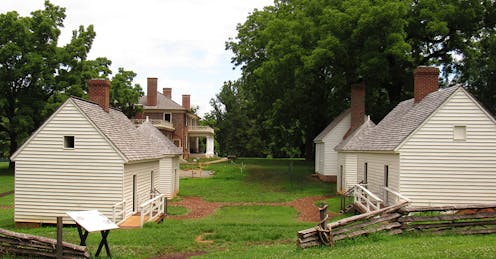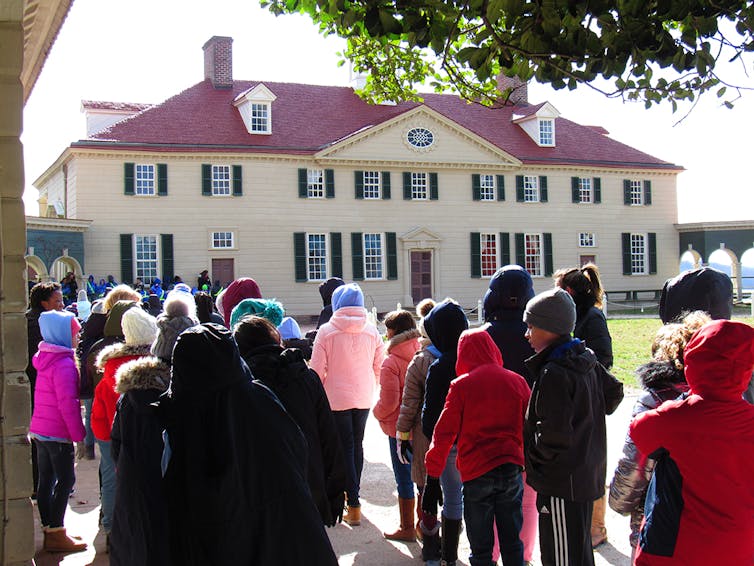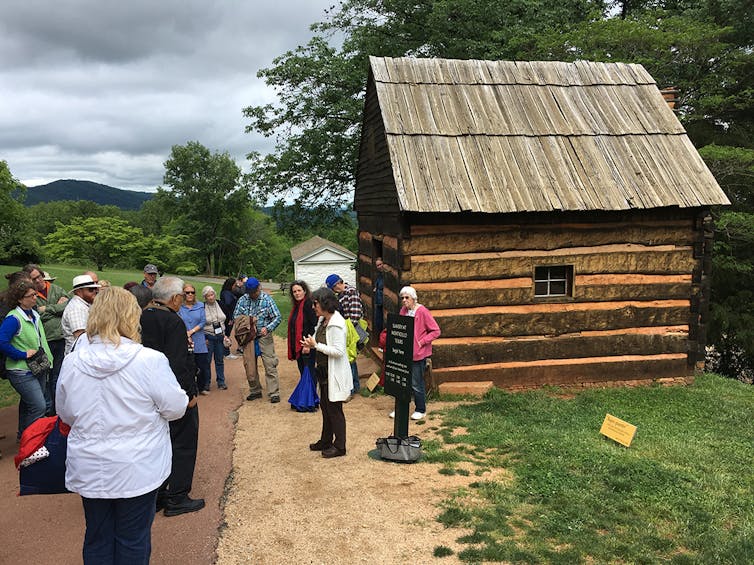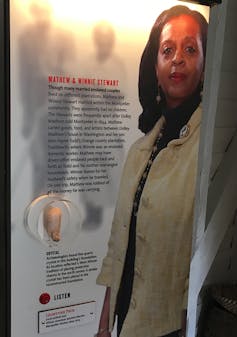Modern-day struggle at James Madison's plantation Montpelier to include the descendants' voices of t
Once owned by James Madison, the Montpelier plantation remains a model for presenting a full depiction of the life of the former president as well as the lives of those he enslaved.

On May 17, 2022, after weeks of negative stories on Montpelier in the national press, the foundation that operates the Virginia plantation home of James Madison finally made good on its promise to share authority with descendants of people enslaved by the man known as “the father” of the U.S. Constitution.
This agreement is the result of a long struggle by this descendant community to make enslaved people more prominent in the history Montpelier offers the public.
Though presidential plantation museums began addressing the topic of enslavement over 20 years ago, descendants were not given power over their ancestors’ stories.
In 2018, provoked by years of slavery’s being taught in erroneous ways, a summit of educators, museum professionals and descendants gathered at Montpelier to define a set of best practices for how historic sites should work with descendant communities.
Ensuring that enslaved people’s descendants have power and authority within these institutions is central to the guide.
Working toward that goal in 2021, Montpelier announced a historic agreement giving descendants equal representation on its board of directors.
These innovations made Montpelier a leader in slavery interpretation.
But that status was threatened earlier this year when Montpelier dissolved its power-sharing agreement with the descendant community.
The foundation’s chairman said the board “has found the committee (representing descendants) difficult to work with.”
Montpelier also fired senior staff who protested this decision, accusing them of speaking “disparagingly, even hatefully, of the volunteer Board that governs this historic American Treasure.”
A firestorm of protest erupted.
Thousands signed petitions urging Montpelier to live up to its promise to work with the descendants. The National Trust for Historic Preservation, which owns Montpelier, stated that the foundation’s actions “would set back Montpelier’s efforts to continue the necessary work of uplifting descendant’s voices.”
Our research at Montpelier and at George Washington’s Mount Vernon and Thomas Jefferson’s Monticello suggests descendant community involvement with the operations of a site affects what visitors learn about slavery at these museums.
As cultural geographers studying how enslavement is presented at historic sites, we realize the importance of creating bonds between visitors and the struggles of enslaved communities at these historic homes.
Such bonds help the public understand slavery’s role in the lives of the Founding Fathers and in the creation of the American nation.
Descendant voices at plantation museums
Montpelier, Monticello and Mount Vernon are popular tourist destinations in Virginia where the public can experience, interpret and identify with historical figures and events.
Before the pandemic in 2020, staff estimated that each year 125,000 people visited Montpelier, over 400,000 visited Monticello and over 1 million visited Mount Vernon.
Some of these visitors find it hard to reconcile the Founding Fathers’ contributions to American democracy with their enslavement of Black men, women and children.

For most of their histories, presidential sites catered to mostly white visitors by downplaying slavery to maintain the reputations of national heroes.
Descendant communities increasingly claim presidential plantations as sites where they can incorporate their historical struggles and contributions into the nation’s story.
This places them front and center in the ongoing battle over how slavery is remembered at the homes of America’s first presidents.
Anthropologist Antoinette Jackson argues that descendant community involvement with plantation museums helps the public understand the diversity of Black lives before and after emancipation.
Her research also suggests that descendant voices disrupt the long-standing white-centric history told at historic sites that has downplayed the everyday practices of living, resisting and surviving that characterized enslaved communities.
Studying visitor experiences
To determine the effect that descendant community involvement had on visitor experiences at Montpelier, Monticello and Mount Vernon, we surveyed 1,386 adult visitors when they first arrived in 2019 and 2020.
We also documented the three museums’ tours and exhibits and surveyed 1,033 adult visitors as they left. The overwhelming majority of visitors – 86% – identified as white, suggestive of how uninviting these sites have been to people of color.
On the pre-visit survey, 81% of visitors said they were very to extremely interested in learning about Madison, Jefferson and Washington. In comparison, only 57% said they were very or extremely interested in learning about enslavement.
Over 90% of visitors took tours of the presidents’ mansions. While enslavement was mentioned on these tours, guides pointed at antique desks and painted portraits to emphasize that Washington, Jefferson and Madison were key players in America’s founding.
According to staff we interviewed, descendants had little say over the content of mansion tours.
Descendant involvement in the sites’ slavery tours and exhibits varied across the the three sites.
The “Slavery at Monticello” tour included enslaved people’s biographies drawn from the oral history project Getting Word, in which descendants shared their stories and those of their ancestors with museum staff.
On the tour, guides mention that members of the Fossett family, for instance, purchased their freedom, moved to Cincinnati and helped fugitive slaves find freedom.


At Montpelier, descendants helped design “The Mere Distinction of Colour” exhibit. It featured the voices of descendants who connected the facts of slavery in America’s past to its legacy in the nation’s present.
At Mount Vernon, the material presented on tours and exhibits that focused on enslavement was thorough and well researched, but contributions of descendants were not featured as much as at the other two museums.
After their visits, people at all three sites reported learning more about Washington, Jefferson and Madison than about enslaved people.
They also stated that these three men had a greater impact on the development of the United States than slavery did.
These results are not surprising.
Visitors arrived more interested in learning about the presidents and almost all took the mansion tours where guides talked more about the Founding Fathers’ accomplishments than enslavement.
The impact of different voices
Between 40% and 70% of surveyed visitors experienced tours or exhibits about enslaved people, but the voices of descendants made visitor experiences at Montpelier and Monticello much different than at Mount Vernon.
Forty percent of 140 Montpelier visitors surveyed reported learning a great deal about enslaved people.
In comparison, 32% of 389 Monticello respondents and only 16% of 504 Mount Vernon visitors said they learned a great deal.
Descendant voices at Montpelier and Monticello also helped visitors understand slavery’s impacts on the development of the United States. Fifty-seven percent of respondents at these sites stated that slavery had a great deal of impact on the nation. Only 42% of Mount Vernon visitors said the same.
Finally, visitor experiences are influenced by how much they engage emotionally with what is said in museum tours and exhibits.
The voices of descendants made a difference in this regard.
At Montpelier and Monticello, over 80% said felt more empathy for enslaved people because of their visit. In contrast, just over 70% of Mount Vernon visitors said their empathy increased.
Tough choices
Presidential sites of the Founding Fathers are popular destinations that help people form their understanding of American history.
Their plantations are key elements for the public to put presidential reputations in conversation with the struggles of enslaved people and the voices of their descendants.
But as presidential museums try to redress their longtime neglect of enslaved Black people, a few vocal visitors accuse guides of attacking the reputations of the white founders.
In our view, museums must be mindful of the roles they play in either reproducing or challenging racial exclusions still found in American understanding of history.
Intensive public criticism helped make the Montpelier Foundation choose to challenge such exclusions.
On May 25, 2022, the new governing board, half of whose members are now enslaved people’s descendants, named Elizabeth Chew as new interim president. Along with two others, Chew had been fired on April 18, 2020, as chief curator of the presidential home.
While accepting the new position she said, “We must embrace history’s complexity and welcome the leadership of the living voices for those who were silenced here.”
Stephen P. Hanna is affiliated with American Association of Geographers
Amy Potter receives funding from National Science Foundation.
Derek H. Alderman receives funding from the National Endowment for the Humanities and is affiliated with the American Association of Geographers..
Read These Next
As DOJ begins to release Epstein files, his many victims deserve more attention than the powerful me
Powerful men connected to Jeffrey Epstein are named, dissected and speculated about. The survivors,…
People are getting their news from AI – and it’s altering their views
Even when information is factually accurate, how it’s presented can introduce subtle biases. As large…
Medieval peasants probably enjoyed their holiday festivities more than you do
The Middle Ages weren’t as dreary and desperate as you’d think, and peasants often had weeks of…





